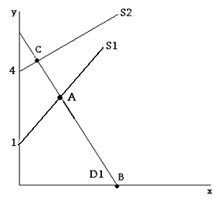Problem 1. Give the slope and the x and y intercepts of the following lines:
a. y = 4x-2
b. y/4+1/2 = x
c. 2y+3 = 4x
d. y = x
Problem 2. Let the horizontal axis be the X variable and the vertical axis be the Y variable. Solve each equation system, i.e. show the value of X and Y that is the solution for each set of equations.
a. y = 4x-2, 2y+3 = 4x
b. y = 4x-2, y=x
c. x = y+5, 2x = y - 2

Problem 3. Use the figure above to answer the following questions:
a. If D1 is described by the equation y=10-2x, then what are the x-intercept and y-intercept of D1?
b. If S2 has a slope of 1/2, then what is the equation specifying S2? What is point C (give the x and y coordinates)? (D1 is still as in part (a) )
c. If S1 has a slope of 1, then what is the equation specifying S1? What is point A (give the x and y coordinates)? (D1 is still as in part (a) )
Problem 4. Daniel and Misuzu must prepare a presentation for their microeconomics class. As part of their presentation, they must do a series of calculations and prepare 50 PowerPoint slides. It would take Daniel 10 hours to do the required calculations and 10 hours to prepare the slides. It would take Misuzu 12 hours to do the calculations and 20 hours to prepare the slides.
a. How much time would it take the two to complete the project if they divide the calculations equally and the slides equally?
b. How much time would it take the two to complete the project if they use comparative advantage and specialize in calculating or preparing slides?
c. If Daniel and Misuzu have the same opportunity cost of $5 per hour, is there a better solution than for each to specialize in calculating or preparing slides?
Use the following table to answer questions 5-8.
Hours needed to make one unit of: Amount produced in 2400 hours:
Car Helicopter Cars Helicopters
Japan 40 160 60 15
U.S. 50 150 48 16
Problem 5. Assume the PPF for both countries is linear with constant slopes. Draw the production possibilities frontiers (PPFs) for Japan and U.S. with cars on the horizontal axis and helicopters on the vertical axis, what are the horizontal and vertical intercepts? Assume both countries have 2400 hours.
Problem 6. What is the opportunity cost of 1 car for U.S.? What is the opportunity cost of 1 helicopter for U.S.? What is the opportunity cost of 1 car for Japan? What is the opportunity cost of 1 helicopter for Japan?
Problem 7. Which country has comparative advantage in producing cars? Which country has comparative advantage in producing helicopters?
Problem 8. Which country has absolute advantage in producing cars? Which country has absolute advantage in producing helicopters?